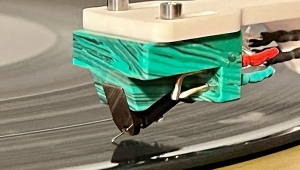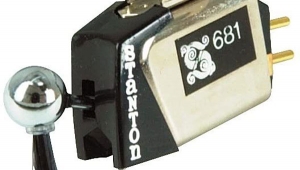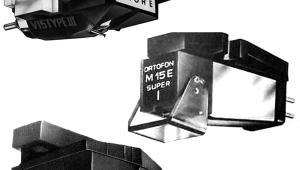| Columns Retired Columns & Blogs |
London (Decca) Jubilee/Reference phono cartridge Page 2
Some critics have described the standard Decca body as "'kin' plastic." In previous reviews, I had found structural resonance problems in the 200–300Hz region. The Jubilee's new body is precision-machined to be closefitting, and is quite inert. It also provides a clean, flat surface for mounting—complete with internal threads to take well-tensioned fixing bolts. The body mass is up from 4 to 10gm. This is a radical transformation, and should allow the "Positive Scanning" generator to operate to its best ability.
The Jubilee is fitted with the latest extended elliptical (or, more correctly, line-contact) stylus designed and ground by Wyndham Hodgson of Expert Pickups (UK). Made from natural, grain-oriented diamond, it offers a combination of low tip mass and improved tracing accuracy (especially toward the end of side), coupled with long life. A quick look using x50 and x100 magnification with quartz-halogen spot illumination showed the stylus to be well-formed and polished, with a precision mounting.
As with any cartridge, due consideration must be given to the infrasonic arm/cartridge resonance behavior. In a typical arm, the Jubilee actually features two resonances, due to the significantly different values for vertical and lateral compliance. In addition, there is almost no damping of the lateral modes. As with previous Decca cartridges, silicone dashpot damping of the tonearm is a necessity when using the Jubilee, in my opinion.
If you don't use damping with a conventional rigid tonearm, a Decca cartridge will be heard to be in a state of almost constant instability. Not only will the trackability be variable, a "fluttering" affecting channel stability and surface noise will also be heard. With a low-mass tonearm, the lightweight Blue or Gold Deccas will place the vertical resonance in the audible range, typically 20–25Hz, with some +4dB, –6dB of subsequent frequency-response variation. The Jubilee tries to avoid these problems by placing the arm/cartridge resonance below 20Hz with a typical tonearm of 10gm effective mass.
A 2gm downforce is recommended for the Jubilee, with a range of 1.8–2.2gm possible, depending on the sample and on the tonearm/turntable used. Rather than the odd, common-ground, three-terminal arrangement of the older Decca designs, the Jubilee features a normal arrangement of four gold-plated output pins. As regards finish, the polished, gold-anodized Jubilee really looks the part!
Sound
In optimal tune and on discs that didn't tax its tracking abilities, the Jubilee achieved unrivaled dynamics. In this regard, it was the best phono cartridge I've tried—and by some margin! That's what we lost with the flimsy body and mounting used for the older Decca models. My experience proves the direct-coupled principle in spades—at least so far as dynamics are concerned.
The dynamic expression was revelatory, even state-of-the-art; if you like, it sounded "direct-coupled." On top-class, original analog material, the Jubilee made even the best digital replay sound a little tired and washed out. The cartridge was capable of generating spine-tingling excitement!
And there was more! Matching its amazingly natural dynamic expression was a textbook reading of pace, rhythm, and timing in the recorded music. Again, digital remasters replayed on CD were heard to be more downbeat, slower-paced, less convincingly and coherently timed. But on LP with the Jubilee, the band played together with an upbeat, lively quality, drawing the listener into the performance.
But now the downside. Good, well-modulated recordings contain peak amplitudes that are beyond the compass of Deccas—even the Jubilee. The cartridge sounded pretty wonderful until it failed to track, when all hell broke loose. It doesn't mistrack in a subtle manner—you know immediately from the edgy, ringing rattles it produces that something is wrong. Nothing I could do with respect to setup or ancillary components did much to push the trackability envelope.
Tonally, the Jubilee was generally well-balanced, with a smooth, wide response—that is, until it got loud. From "loud" up to the tracking threshold, the Jubilee sounded perceptibly hardened, with a thinner, more nasal, and punchier sound. (And no, I don't think the good dynamic expression was the result of this aspect of its sound.)
Most of the time the Jubilee sounded well-detailed, with fine separation of instrumental lines. But as the going got tough, the Jubilee drew back, with less clarity and more muddle as a result. On heavy rock, the sound was electrifying, but the levels of high-frequency modulation were wearing on the cartridge, which reacted in its defense by beginning to gray the grooves!
In the treble, the Jubilee sounded cleaner, clearer, and purer than the older-style Deccas—something I attribute to the new, inert alloy casing. Likewise, the "boxy" Decca colorations in the lower midrange had been vanquished. As cartridges go, the older-series designs were more than a mite colored; by contrast, the Jubilee ranked as a low-coloration design. The bass sounded soft and uneven compared with a Koetsu or a Linn Troika, but it was still quite good.
Soundstage width was fine, while stage depth was certainly above average—good generally, but not up with the Lyra or the Koetsu, and far behind the vdH Grasshopper GLA.
So there it is: the new Jubilee offers a greater degree of "Decca" heaven, yet that taste of hell remains.
In my opinion, a cartridge's first duty is to track the typical range of groove modulations cleanly and convincingly with minimal wear. The Jubilee still does not attain this required standard, and no amount of musical magic will shift my opinion. Only when the Jubilee can be made to keep in safe contact with the vinyl roadway can its panoply of virtues be appreciated.
Conclusion
Reviewing London's (Decca) Jubilee has been one of those fascinating challenges which can both educate and entertain. The Jubilee sounds marvelous so far as its dynamic expression and rhythm are concerned, where it sets an example to all. A cartridge like this is a must-have for those enthusiasts who value such qualities above all others.
However, this is also a significantly flawed cartridge. This may not prove fatal—it just depends on the demands you plan to make on it, and the care you can lavish on both system-matching and alignment. As in the old nursery rhyme, when it's good, the Jubilee is very, very good; but when it's wrong, it can be horrid.
At its best, the Jubilee was stable and sounded neutral and clean. Technically, it represents a substantial advance for the Decca technology, although the distortion and tracking limit both need more work.
Objectively, the Jubilee's sound hardened with increasing third-harmonic distortion at higher recorded levels, to the point where it mistracked the highest and most complex sections of fine recordings. Much of the time it stayed in contact with the groove walls, but when it hit a particular vocal line, a big orchestral climax, or a rock album with a hot cut, like an old Porsche 911 on a fast bend, it disappointed.
I didn't remove the Jubilee from my disc player without some regrets. I shall miss those dynamics, that rock-solid timing, and that lively pace. I certainly shan't forget that such a standard is possible from LP replay.—Martin Colloms
- Log in or register to post comments



































